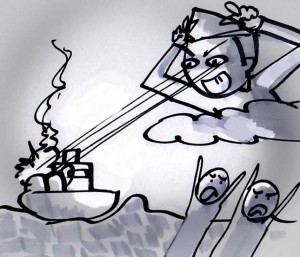War technologies need safety checks
Students who attended the TEDxUSC conference in Bovard Auditorium on Tuesday learned about the power of new technologies and the power of innovation.
Technology influences every aspect of our society — especially the way we conduct war. But we need to keep careful watch over that technology to make sure it doesn’t become dangerous and detrimental.
As our weapons become more advanced, technology is progressively replacing humans on the battlefield, in the sky and in the ocean.
Progress in war technology is neither inherently good nor inherently bad.
The potential for growth is tremendous and exciting, but, as the nature of conflict changes, many challenges await.
One challenge will be addressing concerns about safety.
Last Friday, the Navy released a video of its Maritime Laser Demonstrator firing a laser beam at a motorboat a mile away.
The beam hit the motorboat and set it on fire, disabling it completely.
The Navy has been working on lasers for some time now, but Friday was the Navy’s first successful test of a laser on the water.
The Navy hopes to install lasers like the Demonstrator aboard its ships, with the aim of giving its vessels the capability to destroy enemy ships and even burn incoming missiles out of the sky.
With this ability, the United States would have a significant advantage over other nations in regard to nuclear weapons, as the United States would hypothetically gain the power to incapacitate nuclear-armed missiles midflight.
Still, most technology is far from perfect, and when technology fails on the battlefield, people die.
Earlier this week, an American Predator drone accidently killed two American soldiers in Afghanistan, the first instance of friendly fire from an unmanned aircraft.
Unmanned aircrafts have already changed the way wars are fought from the sky.
Drones have increased attacks on the Taliban in Afghanistan and Pakistan, while pilots controlled them from hundreds of miles away.
In this case, the person operating the unmanned aircraft might have confused the American soldiers for Taliban. If that was the case, that person would be the one to blame.
But who bears the responsibility when an unmanned machine malfunctions in a foreign country and kills innocent people?
As robots are becoming more autonomous with advancements in artificial intelligence (Northrup Grumman, one of the leading American defense contractors, has already developed an unmanned, autonomous helicopter that conducts surveillance, designates targets and assesses battlefield damage all on its own) policymakers need to have a long discussion about who bears the responsibility for robots at war.
Policymakers and military strategists also need to address the lack of vision for these new and powerful machines.
The United States must develop a central idea that can guide how American unmanned weapons are used moving forward.
The United States also needs to reform the rules of warfare to, for example, clearly define what constitutes unmanned action abroad.
The United States is attacking Taliban strongholds in Pakistan with drones, but President Barack Obama will never utter the words ‘the War in Pakistan.’
In his book Wired for War, P.W. Singer talks about the point of singularity — the state in which things become so radically different the old rules break down and we know virtually nothing.
To avoid complete confusion, policy makers need to face the challenges technological innovation has created if this paradigm shift is actually coming.
William Fay is a senior majoring in international relations. His column, “Facing Our Global Challenges,” runs every other Thursday.


“Progress in war technology is neither inherently good nor inherently bad.” – So use some of it on your family, then ask again dummy.